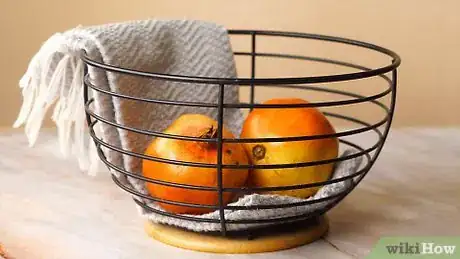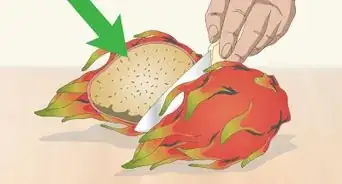This article was co-authored by wikiHow Staff. Our trained team of editors and researchers validate articles for accuracy and comprehensiveness. wikiHow's Content Management Team carefully monitors the work from our editorial staff to ensure that each article is backed by trusted research and meets our high quality standards.
There are 9 references cited in this article, which can be found at the bottom of the page.
The wikiHow Culinary Team also followed the article's instructions and verified that they work.
This article has been viewed 195,726 times.
Learn more...
Pomegranates are an autumn fruit, and you can find the ripest ones at the end of the season.[1] Unlike eating other fruits, you eat the seeds, or arlis,[2] of the pomegranate, which are filled with delicious juice. While choosing the right pomegranate and removing the seeds takes a little more work than doing so for other fruits, it's worth the effort!
Steps
Selecting a Pomegranate
-
1Select a heavy pomegranate. While at the grocery store or farmers market, choose the heaviest pomegranates to purchase.[3] The weight of the pomegranate signifies how juicy it is. Lighter pomegranates do not contain as much juice as heavier ones.
- Although you could weigh each pomegranate on a produce scale, you don't necessarily need to do so. Just grab one in each hand and continue comparing until you have found the heaviest ones.
-
2Choose a pomegranate with a deep colored rind. The rinds vary in shades of red, from bright to more brownish[4] or even pink.[5] The rind should also be glossy.[6] While the shade of the rind doesn't signify anything about ripeness or flavor, the deeper the color, the better.[7]Advertisement
-
3Examine the shape. Unripe pomegranates are round, like apples. However, their shape changes slightly as the fruit ripens and the juice-filled seeds begin to expand outward and press against the insides of the pomegranates. A ripe pomegranate will have more of a square shape because the sides will be flattened (instead of rounded).[8]
-
4Test the fruit for any soft areas. To be sure your pomegranates aren't bruised, hold each pomegranate and gently squeeze it. The pomegranates should be hard, with no mushy spots.
-
5Select pomegranates with smooth, unbroken surfaces. The rind should be soft enough to scratch. If so, you know you have a ripe pomegranate. Unripe pomegranates have very hard rinds that cannot be scratched.[9]
- However, in very ripe pomegranates, the rind will be splitting open because the seeds are filled with juice and are expanding, which puts pressure on the outside of the pomegranate, causing the rind to split. You're more likely to find pomegranates like this at the end of Autumn, when they are ripest, and at your local farmers market (rather than the supermarket).[10]
Removing the Seeds
-
1Dress appropriately. Before de-seeding your pomegranate, you may want to grab an apron or change into an old shirt that you don't mind getting stained. The juice from pomegranates will stain your clothes, so you might not want to wear your favorite outfit while removing the seeds![11]
-
2Cut your pomegranate into quarters.[12] The rind of pomegranates are hard, and you can't really peel a pomegranate because the seeds are nested into and attached to the internal membrane. To get to the edible part of the pomegranate, you'll need to cut into and through the rind. Cutting the pomegranate into quarters rather than halves will give you better access to the seeds.
-
3Fill a bowl with water. Select a bowl in which you can submerge your pomegranate quarters. A medium size mixing bowl should be deep enough. Leave enough space in the bowl to place your hands into it without causing the water to overflow.[13]
-
4Place your quartered pomegranate in the water-filled bowl.[14] Removing the seeds of the pomegranate in water is the easiest way to de-seed your fruit because the seeds are heavier than the membrane that surrounds the seeds. Thus, the seeds will sink to the bottom of the bowl, and the membrane will rise to the surface.[15]
- Alternately, you can remove the seeds over the bowl and let the flesh and seeds drop into the bowl (rather than submerging the pomegranate in the water).[16] This way, you can immediately dispose of the rind when you have removed all the seeds.
- Removing the seeds underwater, however, lessens the risk that you may drop part of the pomegranate onto your counter top and stain it.[17]
-
5Separate the seeds from the flesh. While submerged in the water, hold the pomegranate quarter with one hand, and run the thumb of your other hand around the clumps of seeds.
- Once you have removed all the seeds, you can skim off the membrane from the top of the water with your hands or a small strainer. Remove the seeds from the bottom of the bowl in the same manner.[18] Enjoy eating the plump seeds or prepare for storage!
Storing a Pomegranate
-
1
-
2Store your pomegranate in a dry, cool place. It will last for about a month this way[21] and for a week at room temperature.
-
3Refrigerate the seeds. After removing the seeds from your pomegranate, you can store them in the refrigerator for five days. Be sure, however, to seal them tightly in a container or plastic bag before storing them.[22]
-
4Freeze the seeds.[23] If you don't plan on eating your seeds within a few days, you can prolong the freshness by storing them in the freezer.
- Be sure the seeds are completely dry before freezing them.[24] Otherwise, they will clump together.
- You can also flash freeze the seeds before freezing them in a storage bag. After drying any remaining water off the seeds, place them in a single layer on a wax-paper lined baking sheet. Freeze them on the baking sheet for two hours before storing them in a freezer bag.[25]
- Pomegranate seeds can be stored in the freezer for about a year and are best if used within a year[26] .
Community Q&A
-
QuestionMy pomegranates are ripe now, in April, but I would like to know how I can store them until October, when I need them for a special occasion?
 Community AnswerFreezing is a great option. Remove the arils, wash them to remove any white bits that remain, thoroughly dry them, and then place them on a baking sheet in the freezer. This is important, otherwise the arils will freeze together en mass and then burst when they defrost. Once the arils have frozen completely, then you can place them in a zip lock bag and store in the freezer till you need them. Once October arrives, take the bag out and defrost. The arils should stay intact, and this method minimizes the amount of juice wasted during the defrost process.
Community AnswerFreezing is a great option. Remove the arils, wash them to remove any white bits that remain, thoroughly dry them, and then place them on a baking sheet in the freezer. This is important, otherwise the arils will freeze together en mass and then burst when they defrost. Once the arils have frozen completely, then you can place them in a zip lock bag and store in the freezer till you need them. Once October arrives, take the bag out and defrost. The arils should stay intact, and this method minimizes the amount of juice wasted during the defrost process. -
QuestionHow can I store a whole pomegranate for several months to be used on a special occasion?
 Community AnswerPut it in a plastic bag and close it so it's airtight (the ones in grocery stores for fruit and veggies work well), then put it in the refrigerator and it will last for up to 3 months.
Community AnswerPut it in a plastic bag and close it so it's airtight (the ones in grocery stores for fruit and veggies work well), then put it in the refrigerator and it will last for up to 3 months. -
QuestionIf the seeds are like eating unpopped popcorn, do I still chew them up and swallow them?
 Community AnswerYes. Pomegranate seeds are similar in size to corn kernels, but they're not hard like popcorn. They're surrounded by soft fruit.
Community AnswerYes. Pomegranate seeds are similar in size to corn kernels, but they're not hard like popcorn. They're surrounded by soft fruit.
Things You'll Need
- Fridge or freezer for longer storage
- Freezer storage bag for seeds if freezing
- Container for refrigerating
- Baking sheet & wax paper if flash freezing for storage
- Medium or large mixing bowl
- Strainer (optional)
References
- ↑ http://www.simplyrecipes.com/recipes/how_to_cut_and_de_seed_a_pomegranate/
- ↑ http://www.simplyrecipes.com/recipes/how_to_cut_and_de_seed_a_pomegranate/
- ↑ http://www.latimes.com/food/la-fo-pomegranates-s-story.html
- ↑ http://www.latimes.com/food/la-fo-pomegranates-s-story.html
- ↑ http://www.latimes.com/food/la-fo-pomegranates-s-story.html
- ↑ http://www.crec.ifas.ufl.edu/extension/pomegranates/recipes.shtml
- ↑ http://www.latimes.com/food/la-fo-pomegranates-s-story.html
- ↑ http://www.crec.ifas.ufl.edu/extension/pomegranates/recipes.shtml
- ↑ http://www.crec.ifas.ufl.edu/extension/pomegranates/recipes.shtml
- ↑ http://www.simplyrecipes.com/recipes/how_to_cut_and_de_seed_a_pomegranate/
- ↑ http://www.sparkpeople.com/resource/perfect_prod_detail.asp?ppid=80
- ↑ http://www.latimes.com/food/la-fo-pomegranates-s-story.html
- ↑ http://www.self.com/flash/nutritionnews/2012/10/what-exactly-are-pomegranates/
- ↑ http://www.self.com/flash/nutritionnews/2012/10/what-exactly-are-pomegranates/
- ↑ http://www.simplyrecipes.com/recipes/how_to_cut_and_de_seed_a_pomegranate/
- ↑ http://www.simplyrecipes.com/recipes/how_to_cut_and_de_seed_a_pomegranate/
- ↑ http://www.simplyrecipes.com/recipes/how_to_cut_and_de_seed_a_pomegranate/
- ↑ http://www.simplyrecipes.com/pomegranates/
- ↑ http://www.latimes.com/food/la-fo-pomegranates-s-story.html
- ↑ http://www.fruitsandveggiesmorematters.org/pomegranate
- ↑ http://www.fruitsandveggiesmorematters.org/pomegranate
- ↑ http://www.sparkpeople.com/resource/perfect_prod_detail.asp?ppid=80
- ↑ http://www.latimes.com/food/la-fo-pomegranates-s-story.html
- ↑ http://www.simplyrecipes.com/recipes/how_to_cut_and_de_seed_a_pomegranate/
- ↑ http://www.simplyrecipes.com/recipes/how_to_cut_and_de_seed_a_pomegranate/
- ↑ http://www.crec.ifas.ufl.edu/extension/pomegranates/recipes.shtml
- ↑ http://www.simplyrecipes.com/recipes/how_to_cut_and_de_seed_a_pomegranate/
About This Article
To select and store pomegranates, start by choosing pomegranates that are heavy and square shaped, which are signs that they're ripe and juicy. You should also try to avoid pomegranates that are bruised or broken. When you're ready to store your pomegranates, put them in your fridge where they'll last for a couple of months. If you plan on eating them soon, you can keep pomegranates at room temperature for up to a week. If you've already taken the seeds out of them, refrigerate the seeds in a plastic container or bag for up to 5 days. If you want to learn how to remove the seeds from the pomegranates, keep reading the article!





























































